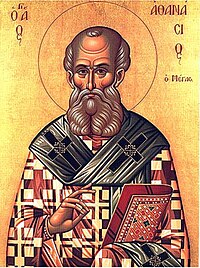 |
| Duccio di Buoninsegna |
You can find the readings and responsories for the feast here, and additional notes on saying and/or singing Matins of the feast here.
You can also find Pope Benedict XVI's General Audiences on these saints here:
Focusing on the Traditional Benedictine Office in accordance with the 1963 Benedictine calendar and rubrics, including the Farnborough edition of the Monastic Diurnal.
 |
| Duccio di Buoninsegna |

Gregory Nazianzus, a noble Cappadocian, earned the name of The Divine from his extraordinary knowledge of the sacred sciences. It was to these that he turned after being educated at Athens, together with St. Basil, in every branch of learning. He was first made Bishop of Sosima and then administered the Church of Nazianzus. Summoned to rule over the Church of Constantinople, he purged the city of heretical errors and brought it back to the Catholic faith. Although this deed should have won him the love of all, it earned him the hatred of many; so that, when a great quarrel had arisen among the bishops on his account, he resigned his See voluntarily, making his own the words of the prophet Jonah: If this storm hath arisen on my account, then throw me into the sea, that you may cease to be tossed about. He returned to Nazianzus, and having arranged that Eulalius should be its bishop, devoted himself wholly to prayer and the study of divine things. He wrote many famous works, both in prose and in verse, and was a most ardent defender of the doctrine of the consubstantiality of the Son with the Father. When Theodosius was emperor, Gregory, now grown old, departed to the life of heaven.If you would like to know more about the saint and his teachings, Pope Benedict XVI gave two General Audiences which you find by following the links:

After that famous victory which the Emperor Constantine gained over Maxentius, in the year 312, on the eve of which the banner of the Cross of the Lord had been given to him from heaven, Helen, the mother of Constantine, being warned in a dream, came to Jerusalem, in 326, to seek for the Cross. There it was her care to cause to be overthrown the marble statue of Venus, which had stood on Calvary for about one hundred and eighty years, and which had originally been put there to desecrate and destroy the memorial of the sufferings of the Lord Christ. The like work Helen did at Bethlehem, by cleansing from an image of Adonis the stable where the Saviour was born, and from an idol of Jupiter, the place where He had arisen from the dead.
Then she had thus cleansed the place where the Cross had stood, Helen caused deep excavations to be made, which resulted in the discovery of three crosses, and, apart from them, the writing which had been nailed on that of the Lord. But which of the crosses had been His was unknown, and was only manifested by a miracle. Macarius, Bishop of Jerusalem, after offering solemn prayers to God, touched with each of the three a woman who was afflicted with a grievous disease. The two first had no effect, but at the touch of the third she was immediately healed.
Helen, after she had found the life-giving Cross, built over the site of the Passion a Church of extraordinary splendour, wherein she deposited part of the Cross, shut up in a silver case. Another part which she gave to her son, Constantine, was laid up in the Church of the Holy Cross of Jerusalem, which he built at Rome on the site of the Sessorian Palace. She also gave to her son the nails with which the Most Holy Body of Jesus Christ had been pierced. Constantine established a law abolishing the punishment of crucifixion for all time coming and thenceforth what had hitherto been a hissing and a curse among men, began to be esteemed worshipful and glorious.

Athanasius was Bishop of Alexandria, and a most vigorous defender of the Catholic religion. When he was still a deacon, he refuted the impiety of Arius at the Council of Nicaea, and earned such hatred from the Arians that, from that time on, they never ceased to lay snares for him. Driven into exile, he went to Treves in Gaul. He endured unbelievable hardships and wandered over a great part of the world, being often driven from his Church, and often restored by the authority of Pope Julius and the decrees of the Councils of Sardica and Jerusalem. All this while, he was persecuted by the Arians. Finally, rescued, by the help of God, from so many great dangers, he died at Alexandria during the reign of Emperor Valens. His life and death are marked by great miracles. He wrote many works, both of devotion and of catechetics, and, with great holiness, he ruled the Church of Alexandria, in those most troubled times, for forty-six years.

**Some of the French Congregations, however, seem to have celebrated the feast of St Hugh on this date either instead of St Robert (Cluniacs) or as well as that feast (Solesmes). The 1897 Liber Antiphonarius lists the feast of St Robert in the main calendar, but also adds St Hugh to that day, while preserving separate feasts for St Odilo (Jan 19), Maiolus (May11) and Odo (Nov 27) for their own congregation.In (I think) the early twentieth century clean out of the Benedictine calendar though, the ongoing war between the Black and White monks presumably heated up once more, because the feast of St Robert of Molesmes was replaced by one celebrating several of the Cluniac abbots instead (combining several separate feasts celebrated by some Congregations only), against whom the Cistercian reform was rather directed.